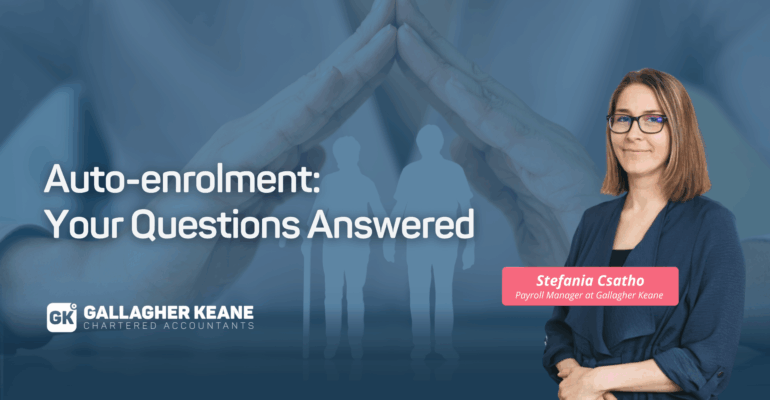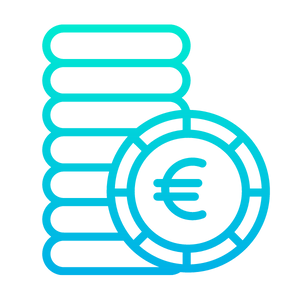Auto-Enrolment: FAQs with Stefania Csatho, Payroll Manager at Gallagher Keane

Auto-Enrolment: FAQs with Stefania Csatho, Payroll Manager at Gallagher Keane
With auto-enrolment launching in 2026, understanding the new retirement savings system is key. Stefania Csatho, Payroll Manager at Gallagher Keane Chartered Accountants, shares her expertise and answers some of the most frequently asked questions, providing employees and employers with clear, practical guidance on what to expect and how to prepare.
What is auto-enrolment?
Auto-enrolment is a new retirement savings scheme where individuals are automatically enrolled once they meet certain conditions. It is designed to provide a retirement plan for people who do not currently have a work-based or private pension.
Why is auto-enrolment being introduced?
There are two main reasons:
- Few people have a work or private pension and will rely solely on the State Pension, which could result in reduced income and a lower standard of living in retirement.
- Ireland’s population is ageing, meaning there will be fewer workers supporting retirees in the future. Starting to save now helps ensure sufficient funds for retirement.
When will auto-enrolment be introduced?
Auto-enrolment will start on 1 January 2026.
Who will be automatically enrolled?
You will be enrolled if you:
- Are aged between 23 and 60
- Earn over €20,000 per year
- Are not currently contributing to a work or private pension through payroll
Who will run the auto-enrolment retirement savings system?
The scheme will be managed by a new independent body, the National Automatic Enrolment Retirement Savings Authority (NAERSA), set up by the Department of Social Protection.
How will auto-enrolment be regulated?
The scheme will be supervised by the Pensions Authority, which will operate independently under a Board of Directors. Participants will also have access to the Financial Services and Pensions Ombudsman.
How will the €80,000 earnings threshold be applied?
The €80,000 threshold refers to gross annual pay. Once you exceed €80,000 in a year, contributions stop for any earnings above this amount. Contributions already made above €80,000 are not refunded.
Example:
- An employee has earned €79,500 by September.
- Their next payroll shows €2,000 gross pay in October, making the annual total €81,500.
- Contributions are taken on the €2,000.
- NAERSA creates a new AEPN with a 0% contribution rate for the remainder of the year.
- At the start of the new calendar year, a new AEPN with the standard contribution rate will be issued.
If I’m working and drawing down a pension will I still be enrolled?
Pension income will not affect eligibility. You will be enrolled if you meet the age and income criteria and are not currently contributing to a supplementary pension through payroll.
If my earnings go below €20,000 a year will I stay in the scheme?
Yes, once enrolled, you will remain in the scheme even if your income falls below €20,000.
Will auto-enrolment replace the State Pension?
No, it is intended to supplement the State Pension, providing an additional way to save for retirement.
If you already have a work pension or personal pension
- If you are currently contributing via payroll, you are not eligible for the scheme.
- If you have more than one job and another role does not have payroll pension contributions, you will be enrolled for that job if combined wages exceed €20,000.
If you used to contribute to a pension but don’t anymore
You will be enrolled if you meet the eligibility criteria.
Can employees keep contributing to their personal pension and be eligible for auto-enrolment?
Any employment without payroll pension contributions is eligible for auto-enrolment. If you contribute via payroll for another role, that employment is excluded. If you later start contributing to a payroll pension, that role will become exempt.
How will NAERSA know that an employee has a private pension?
NAERSA cannot track private pension contributions outside payroll. If you meet the eligibility criteria, you will be automatically enrolled, and you may choose whether to continue both pensions.
Should employees cancel their personal pension so they can be automatically enrolled?
We cannot advise on which is better for your situation. It depends on factors like tax relief, contribution amounts, fees, and benefits.
Will employees be able to take out a private pension after being automatically enrolled?
Yes, you can remain in auto-enrolment while contributing to another pension outside payroll.
Can employees get the State top-up in their occupational or personal pension?
No, the State top-up of €1 for every €3 contributed applies only to auto-enrolment. Other pensions will continue to receive tax relief.
What happens to your savings if you opt-out?
Contributions, including employer and State contributions, remain invested. Even if you opt out, your pot will be available at retirement age.
Are there penalties if employees keep opting out?
No, there are no penalties for opting out repeatedly.
Security of your savings
Your savings pot belongs to you. It is invested securely, supervised by the Pensions Authority, and only you can access it at retirement age.
What happens if you stop working?
Your savings will continue to be invested, but contributions stop. If you return to work and remain eligible, contributions will resume.
What happens if you emigrate?
Savings remain invested and accessible at retirement age. Contributions stop while you are abroad. If you return to work in Ireland, you may be re-enrolled if eligible.
How will my savings be taxed?
- State top-up applies instead of tax relief
- Investments grow tax-free
- Up to 25% of your fund can be taken tax-free at retirement, balance subject to income tax
If your employer doesn’t pay contributions
Legislation ensures employers must contribute, or they may face fines and repayments with interest.
Will I have to pay fees?
Fees will include a small weekly administrative charge and an investment management fee, expected to remain below 0.5% of assets. Inactive accounts will not be charged.
Questions for employers
Do all companies have to implement auto-enrolment?
Yes, all employers must facilitate the scheme for eligible employees. Preventing enrolment may result in fines.
Do I have to enrol my employees on the employer portal?
No. Employers register on the portal, and NAERSA handles employee registration and AEPN updates.
Will I have to tell my employees when they’ve been enrolled?
Yes, employers must inform employees of their enrolment date. Welcome letters are provided via the portal.
Who is considered an employee for auto-enrolment?
An employee is anyone paid by an employer and not self-employed.
Will Community Employment, Job Initiative, Rural Social Scheme, or Tús participants be enrolled?
No, participants are not eligible.
Will supervisors in these schemes be enrolled?
Yes, if they meet eligibility criteria.
Will apprentices be enrolled?
Yes, if they meet eligibility criteria.
Will company directors be enrolled?
Only if paying PRSI as an employee; self-employed directors are not eligible.
Will new employees be auto-enrolled straight away?
Employees with prior earnings over €20,000 are enrolled immediately. New employees without prior records may take up to 13 weeks to establish eligibility.
How will self-employed people be identified?
PRSI classes will be used to exclude self-employed individuals.
Will employees who opted for cash in lieu be enrolled?
Yes, if they meet eligibility and are not contributing to a pension via payroll.
Will employees with pensions abroad but paid through Irish payroll be enrolled?
Yes, if Revenue data shows no active payroll contributions and eligibility criteria are met.
How will salary be assessed for eligibility?
Gross pay on payroll is assessed. Some employees will meet the threshold immediately; others may require up to 13 weeks of review.
Will employers have to contribute to personal pensions now?
No. Employers are only required to contribute to auto-enrolment.
What if employers already have a pension scheme?
Existing schemes continue alongside auto-enrolment. Employees contributing via payroll are not enrolled for that employment.
Can employers automatically enrol employees into their existing pension scheme?
No, the legislation only applies to auto-enrolment.
Will employers still have to provide access to a PRSA?
Yes, existing legislation remains in place.
Do existing schemes need standards to be exempt?
No, payroll contributions already provide exemption. Standards for exemptions will be developed within six years.
If an employee opts out, do employers still pay contributions?
No. Contributions pause and resume upon re-enrolment.
If an employee earns over €80,000 across multiple jobs, how are contributions managed?
NAERSA will update AEPNs for both employers once the threshold is reached. Contributions resume in the new tax year if eligible.
Do employers pay contributions for employees who opt in?
Yes, opt-in employees receive the same treatment as automatically enrolled staff.
Do contribution rates for existing schemes need to match auto-enrolment?
No. Auto-enrolment rates only apply to the scheme.
What counts as salary for auto-enrolment?
Gross pay reported on payroll is used to assess contributions.
How will contributions be paid?
Employers remit employee and employer contributions to NAERSA, using payroll software. Multiple payment methods will be available.
Will additional employer returns be required?
Yes, employers submit a separate payroll return to NAERSA. Contribution calculations are handled through payroll software.
Do we need a broker to manage auto-enrolment?
No. NAERSA administers the scheme centrally.
Contact us:
If you have any questions about auto-enrolment, email Stefania Csatho at payrollmanager@gallagherkeane.ie
Search
Recent Posts
- Auto-Enrolment: FAQs with Stefania Csatho, Payroll Manager at Gallagher Keane
- Why Does Revenue Withdraw Tax Clearance Certificates and How Do I Obtain a New One?
- Tax Reliefs Explained – How They Can Reduce Your Tax
- 5 KPIs Every Growing Business Should Track
- When and How to File Capital Gains Tax (CGT)


